ARCHIVED - Immigration and Refugee Board of Canada
 This page has been archived.
This page has been archived.
Archived Content
Information identified as archived on the Web is for reference, research or recordkeeping purposes. It has not been altered or updated after the date of archiving. Web pages that are archived on the Web are not subject to the Government of Canada Web Standards. As per the Communications Policy of the Government of Canada, you can request alternate formats on the "Contact Us" page.
2009-10
Report on Plans and Priorities
Immigration and Refugee Board of Canada
The original version was signed by
The Honourable Jason Kenney
Minister of Citizenship, Immigration and Multiculturalism
Table of Contents
Message from the ChairpersonSection I: Overview
Section II: Analysis of Program Activities
Section III: Supplementary Information
Message from the Chairperson

I am pleased to present the 2009-10 Report on Plans and Priorities for the Immigration and Refugee Board of Canada (IRB).
The IRB is an independent, accountable tribunal whose work reflects Canada's humanitarian and security values and respect for our international obligations. On behalf of Canadians, the IRB hears a wide variety of cases, ranging from family sponsorship appeals and detention reviews to refugee protection claims and admissibility hearings. This year marks the 20th anniversary of the IRB.
IRB personnel recognize the profound impact of our actions and the consequences of the decisions rendered. It is with this sense of responsibility to those who appear before us and to all Canadians who count on us to resolve cases efficiently, fairly and in accordance with the law, that we undertake the plans and priorities presented in this report.
Caseload and decision-maker complement
The IRB operates in a complex and unpredictable environment where the number and type of cases it receives are influenced by shifting migration patterns, refugee movements and other factors. The IRB's three divisions—the Refugee Protection Division (RPD), the Immigration Appeal Division (IAD) and the Immigration Division (ID)—are experiencing substantial growth in their caseload, and this trend is expected to continue in 2009-10. This is particularly the case in the RPD, which has been receiving new claims at a rate well above the level for which it is currently funded.
As a consequence of this increased workload and the continuing shortfall in the Governor in Council (GIC) decision-maker complement, both the RPD and the IAD continue to accumulate large and growing inventories. The IRB is committed to working with the Government so that it may fill GIC decision-maker vacancies with qualified candidates as quickly as possible. At the same time, the IRB continues to find ways to become more efficient while examining the need for additional resources to address its mounting workload pressures.
In light of the difficulty in forecasting external pressures such as the rate and number of new appointments and reappointments, a range has been provided for proposed case completions by the RPD and the IAD.
Continued organizational transformation
The IRB is engaged in various organizational improvements to ensure that it is well positioned to deliver high-quality administrative justice on a timely basis. In 2009-10, we will build on our achievements by further integrating and streamlining our adjudicative support and case resolution processes without compromising fairness.
Key priorities for 2009-10
We have identified the following three strategic priorities for 2009-10 that build on those from the previous fiscal year.
- Further increase capacity to resolve cases and manage the case inventory
- Strengthen relationships with partners and stakeholders
- Continue to build an integrated, flexible and effective organization
In line with these strategic priorities, the IRB will focus on both new and ongoing initiatives in the year ahead. These include:
- Continued, intensive decision-maker recruitment and selection efforts to ensure that the Government is provided with a sufficient pool of qualified candidates for appointment to the RPD and the IAD
- Further enhancement of adjudicative support, including early resolution of cases and improved case-readiness procedures across all divisions, to ensure that files are hearing-ready and to facilitate proactive hearings
- Development and implementation of quality standards for decision-making and adjudicative support to enhance accountability and transparency
- Enhancement of the outreach program with key partners and stakeholders to improve public understanding of the IRB's mandate and operations
Looking ahead
In 2009-10, we will continue to look for opportunities to improve the way we do business so that we may better deliver on our mandate on behalf of Canadians. I would like to acknowledge the dedication and professionalism of IRB personnel, who are key to our success in meeting our objectives for the year ahead. I invite you to read this report and to visit our Web site at www.irb-cisr.gc.ca for more information about the IRB and its plans and priorities.
Brian Goodman
Chairperson
Section I: Overview
Raison d'être and Responsibilities
The IRB is an independent, accountable administrative tribunal that was created on January 1, 1989, by an amendment to the Immigration Act.
| Our mission, on behalf of Canadians, is to resolve immigration and refugee cases efficiently, fairly and in accordance with the law |
In 2002, the Immigration Act was replaced by the Immigration and Refugee Protection Act (IRPA) from which each IRB division derives its mandate.
| Refugee Protection Division (RPD) |
|---|
|
| Immigration Division (ID) |
|
| Immigration Appeal Division (IAD) |
|
Regional Operations
The IRB carries out its work in three regional offices in Toronto, Montréal and Vancouver: the Central Region, responsible for Ontario, except for the Ottawa area; the Eastern Region, responsible for Quebec, the Ottawa area and the Atlantic provinces; and the Western Region, responsible for the Western provinces. All three divisions hold hearings in these regions, supported by operational and adjudicative support. Internal and support services are managed at IRB Headquarters, located in Ottawa.
Administrative Justice
Through each division, the IRB strives to deliver a simpler, more accessible and expedient form of justice than that provided by the courts, but with no less attentiveness to procedural fairness, the rigour of the law and its application to the particular facts of each case. The IRB applies the principles of administrative law, including natural justice, in its proceedings and resolutions, and decisions are rendered in accordance with the law, including the Canadian Charter of Rights and Freedoms.
The IRB is a human rights tribunal, and the human dignity of all those who come before it is respected by the women and men who work at the IRB. The IRB is committed to fairness in all aspects of its work. The Board respects the diversity of individuals who appear before it, some of whom have experienced very difficult circumstances.
Benefits for Canadians
Immigrants and refugees have always contributed significantly to Canada's growth and development. The IRB ensures continued benefits to Canadians in three important ways:
- In hearings on refugee claims, it ensures that Canada accepts those in need of protection in accordance with international obligations and Canadian law
- In hearings on admissibility and detention reviews, it helps ensure the security of Canadians
- As an independent mechanism for resolving sponsorship, removal order and residency obligation appeals, it helps to promote family reunification, helps ensure Canadians' safety and security, and safeguards the integrity of Canada's immigration system
The IRB also contributes more broadly to the quality of life of Canada's communities by strengthening our country's social fabric and by reflecting and reinforcing core values that are important to Canadians. These include respect for human rights, security, fairness, peace and the rule of law.
Organizational Information
Senior management. The Chairperson is the IRB's Chief Executive Officer, senior decision-maker and spokesperson. The Executive Director is the IRB's Chief Operating Officer and is responsible for providing adjudicative and corporate support to the IRB's three decision-making divisions. Two deputy chairpersons (appointed by the GIC) and one director general (appointed under the Public Service Employment Act) oversee decision-making in the three divisions. Four directors general and a senior general counsel (all appointed under the Public Service Employment Act) are responsible for the IRB's operations, legal services, corporate planning and services, communications and human resources functions.
Decision-makers. Decision-makers in the RPD and the IAD are appointed by the GIC. Decision-makers in the ID are public service employees.
Organizational Chart
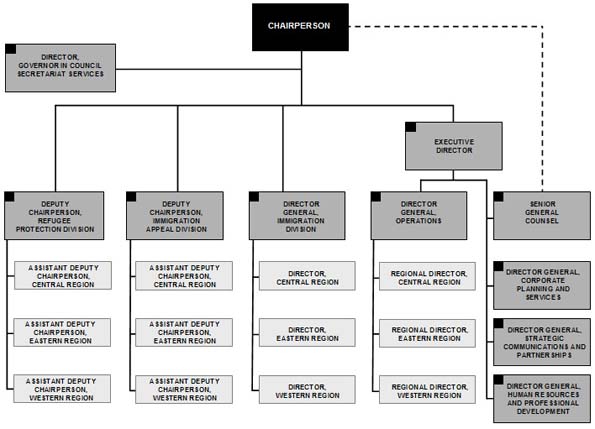
(Click on image to enlarge)
Strategic Outcome and Program Activity Architecture (PAA)
Based on its legislated mandate and its currently approved PAA, the IRB has a single strategic outcome and three program activities that include responsibility for all tribunal decisions and resolutions. The fourth program activity, Internal Services, supports the first three as illustrated by the figure below.
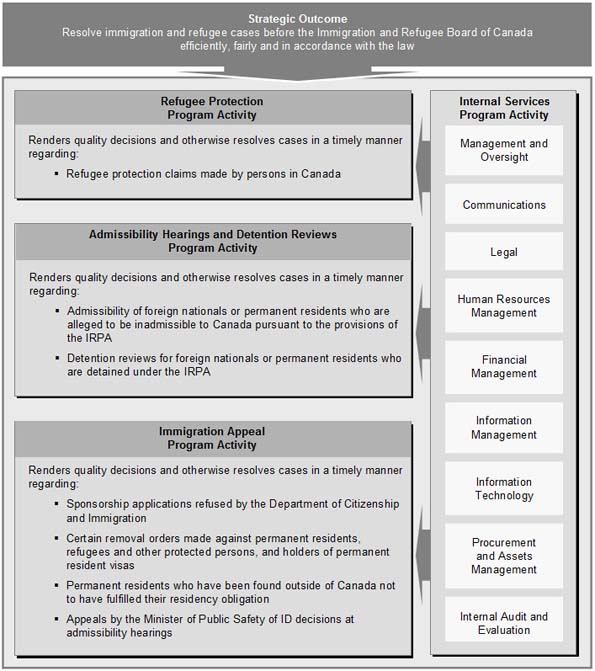
Planning Summary
Financial and Human Resources
| 2009-10 | 2010-11 | 2011-12 |
|---|---|---|
| 113.4 | 113.1 | 112.8 |
| 2009-10 | 2010-11 | 2011-12 |
|---|---|---|
| 1,025 | 1,025 | 1,025 |
Planning Summary Table
| Performance Indicators | Targets |
|---|---|
| In addition to the productivity indicators described for each of the program activities (see Section II), the following quality indicator will be used: Percentage of IRB decisions overturned by the Federal Court | Less than 1% |
| Program Activity | Forecast Spending ($ Millions) |
Planned Spending ($ Millions) |
Alignment to Government of Canada Outcome Area | ||
|---|---|---|---|---|---|
| 2008-09 | 2009-10 | 2010-11 | 2011-12 | ||
| Refugee Protection Program Activity | 59.8 | 60.3 | 60.1 | 60.0 | A safe and secure world through international cooperation |
| Admissibility Hearings and Detention Reviews Program Activity | 8.0 | 11.4 | 11.4 | 11.4 | Safe and secure communities |
| Immigration Appeal Program Activity | 13.8 | 13.2 | 13.2 | 13.1 | A vibrant Canadian culture and heritage; Safe and secure communities |
| Internal Services Program Activity | 30.9 | 28.5 | 28.4 | 28.3 | Government Affairs |
| Total Planned Spending | 112.5 | 113.4 | 113.1 | 112.8 | |
1 For program activity descriptions, please refer to Section II or access the Main Estimates online at http://www.tbs-sct.gc.ca/est-pre/estimE.asp.
IRB Strategic Priorities
The IRB's three strategic priorities for 2009-10 are summarized in the table below.
2009-10 Strategic Priorities
| Priorities | Type | Description |
|---|---|---|
| Further increase capacity to resolve cases and manage the case inventory | Operational Ongoing |
The Board will continue its efforts to assess and recommend qualified candidates to the Minister for appointment to address the shortfall in the GIC decision-maker complement. In addition, the IRB will ensure that it has the necessary resources in place to support its decision-makers. The IRB will also further improve the management of its inventory through innovative case management and adjudicative strategies. |
| Strengthen relationships with partners and stakeholders | Operational New |
The IRB recognizes the importance of positive relationships with its partners and stakeholders. The Board will enhance its outreach efforts and work with key partners and stakeholders to improve public understanding of its mandate and operations. |
| Continue to build an integrated, flexible and effective organization | Management Ongoing |
The Board continues to ensure the consistent delivery of high-quality administrative justice within a changing environment. This transformation process remains a priority in 2009-10, as the Board will further integrate its operations and develop new quality standards in decision-making and adjudicative support to enhance accountability and transparency. |
Risk Analysis
Operating Environment
The IRB carries out its mandate within a complex and ever-changing environment. Both international and domestic factors influence the IRB's operating environment. Conflicts and country conditions abroad can result in refugee movements and inevitably impact the number of refugee protection claims made in Canada. Similarly, shifts in international migration patterns impact the number of people seeking admission to Canada.
Refugee populations. The report Asylum Levels and Trends in Industrialized Countries, First Half 2008, published by the United Nations High Commissioner for Refugees (UNHCR), shows that the number of asylum claims submitted in industrialized countries in 2007 rose by 9% compared to 2006. This upward trend continued in the first half of 2008, with approximately 165,000 claims submitted during this period in the 44 countries surveyed. During this period, only the United States received more refugee claims than Canada.
In Canada, the increase in refugee protection claims that began in 2006 is expected to continue into the 2009-10 reporting period, with Mexico, Colombia and Haiti representing the top source countries for such claims. As of January 2009, we are projecting that the number of claims will increase from 40,000 claims in 2008-09 to 50,000 claims in 2009-10, an increase of 25%. At the same time, the refugee caseload is also becoming more complex, with increased security concerns and fraudulent documentation.
Growing trend of family sponsorships. Immigration continues to be important for Canada, as immigrants represent an increasing proportion of the population. Canada's population of immigrants is expected to reach between 7.0 and 9.3 million by 2017. It is within this context, and consistent with the Government's objective of promoting family reunification that family-class sponsorship applications have increased. With this increase, it is expected that the IRB will continue to receive a high number of family sponsorship appeals.
Challenges
Appointment of decision-makers. Due to a series of transitions in government between 2004 and 2008, the IRB experienced a decline in the rate at which GIC decision makers were appointed and reappointed. The resulting shortfall in decision makers has contributed to the growth of the pending case inventory and to increased average processing times.
While the IRB expects the pace of GIC appointments and reappointments to quicken, it takes approximately six months to train new decision-makers and for them to acquire the experience to become fully productive. In this context, case resolution estimates for 2009-10 for the RPD and the IAD are reported as falling within a range. The upper limit is based on a full complement of decision-makers and the lower limit on a projected vacancy rate of 27%, reflecting the historical appointment patterns of the last two years.
Increase in intake and pending case inventory. The growing inventory is primarily attributable to two external factors: an increasing number of appeals filed and claims referred to the Board; and a reduced number of GIC decision-makers. The IRB is currently funded to finalize 25,000 refugee claims and 6,500 immigration appeals. As of April 2009, it is expected there will be approximately 65,000 refugee protection claims and 10,600 immigration appeals pending. If intake levels and resource levels remain constant, it is expected that the inventory will continue to grow, even with a full complement of decision-makers. While the IRB will continue to seek opportunities to further increase its productivity, workload pressures in the RPD and the IAD are such that changes to resource levels will be required to return the pending inventory to normal operating levels.
Opportunities
Case management. A growing pending case inventory coupled with a shortfall in resources has compelled the IRB to look for innovative ways to address its workload. The Board's case management plan will draw on the benefits of fast track processes, inter regional support and improved case scheduling. These initiatives will leverage the Board's existing resources and tribunal expertise to improve processing times and help reduce the case inventory.
Portfolio management. As immigration portfolio partners, the IRB, CIC and the Canada Border Services Agency (CBSA) collaborate on operational matters while respecting each other's distinct mandates and the IRB's adjudicative independence. A recent trilateral Memorandum of Understanding clearly defines institutional relationships and reflects the current operational environment and priorities of the partners. This new collaborative approach creates opportunities to improve communication and operational coordination. The diagram below illustrates the immigration and refugee portfolio, partners and responsibilities.
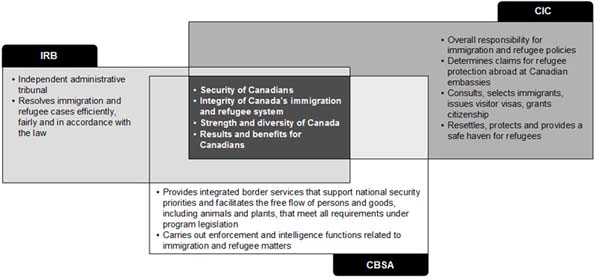
(Click on image to enlarge)
Expenditure Profile
Spending Trend 2005-06 to 2011-12
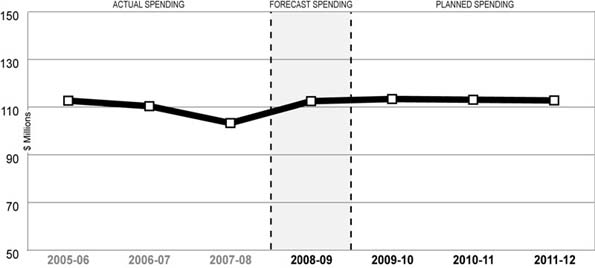
Lower actual spending in 2007-08 in comparison to previous years was primarily due to delays in appointments and reappointments of GIC decision-makers and vacant public service positions. This resulted in fewer adjudicative decisions rendered and translated than originally estimated.
The planned spending for 2009-10 and beyond is expected to remain constant.
Allocation of Funding by Program Activity
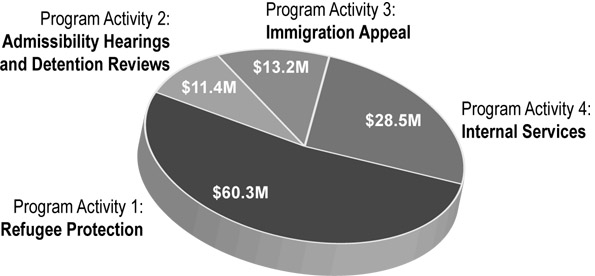
Voted and Statutory Items
| Voted # or Statutory Items (S) | Truncated Vote or Statutory Wording |
2008-09 Main Estimates ($ Millions) |
2009-10 Main Estimates ($ Millions) |
|---|---|---|---|
| 10 | Program expenditures | 100.6 | 100.8 |
| (S) | Contributions to employee benefit plans | 12.8 | 12.6 |
| Total | 113.4 | 113.4 | |
Section II: Analysis of Program Activities
This section provides detailed information on the plans and expected results as well as financial and human resources for the IRB's four program activities.
Strategic Outcome and Program Activities
As discussed in Section I, based on the IRB's legislated mandate and approved PAA, the IRB has a single strategic outcome and three program activities that include responsibility for all tribunal decisions and resolutions. These are supported by Internal Services, which is the fourth program activity. This section further describes the four program activities.
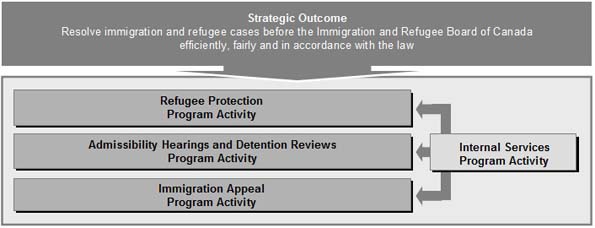
Program Activity 1
Refugee Protection
| Description The RPD delivers the IRB's Refugee Protection program activity. It determines claims for refugee protection made in Canada. Processing of refugee claims is the main focus of the IRB's activities and resources. Through the work of the RPD, Canada fulfills its obligations as a signatory to a number of international human rights conventions. |
| Fiscal Year | 2009-10 | 2010-11 | 2011-12 |
|---|---|---|---|
| Financial Resources ($ Millions) | 60.3 | 60.1 | 60.0 |
| Human Resources (FTEs) | 591 | 591 | 591 |
| EXPECTED RESULT: Quality decisions rendered and cases resolved in a timely manner regarding refugee protection claims made in Canada | |
|---|---|
| Performance Indicator | Targets |
| Clarity, completeness and conciseness of IRB reasons for decisions | Develop criteria for samples of reasons for decisions. |
| Percentage of cases finalized without a hearing | It is expected that 8% of cases will be finalized without a hearing (expedited process). |
| Ratio of finalized cases to referred cases | Approximately 50,000 refugee protection claim referrals are expected to be received in 2009-10. Based on the number of decision-makers available we expect to finalize between 21,000 and 25,000 claims. This will result in a ratio of finalized to referred cases of 42% to 50%. |
| Average cost per claim finalized | The average cost per finalized claim will be between $3,200 and $3,800 depending on the number of claims finalized. |
| Average case processing time | Based on the inventory and the available decision-maker complement, it is expected that the average processing time (from referral to finalization) could increase to 18.5 months. |
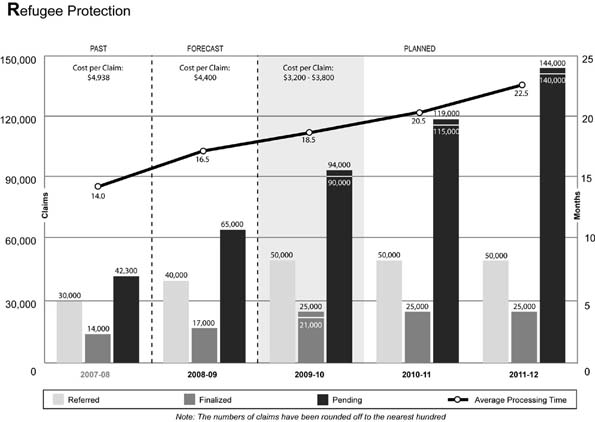
(Click on image to enlarge)
2009-10 Planning Highlights
Further increase capacity to resolve cases and manage the case inventory. The RPD depends on experienced, highly trained decision-makers to provide well reasoned quality decisions in a timely manner. Throughout 2008-09 the RPD operated with approximately 40 fewer decision-makers than its funded level. Between 2007-08 and December 2008 the RPD lost 26 experienced decision-makers due to expired mandates, resignations, or reappointments not being made. The Board will continue to actively recruit for new decision-makers and train appointees to develop the experienced decision-making capacity in the RPD.
The RPD expects to begin the fiscal year with a pending inventory of approximately 65,000 cases. The division expects to receive an additional 50,000 new refugee claim referrals in 2009-10. Depending on the number of the decision-makers available and their level of experience, the RPD expects to have the capacity to finalize between 21,000 and 25,000 claims. Therefore, the pending inventory is projected to reach between 90,000 and 94,000 by the end of 2009-10.
Strengthen relationships with partners and stakeholders. The RPD will continue to use national and regional consultative processes to engage stakeholders and partners in order to find practical solutions to decrease the inventory and develop efficiencies in case management.
Continue to build an integrated, flexible and effective organization. The RPD will enhance certain operational functions and training initiatives and develop new ways to enhance case management processes such as streaming case types for expedited processing and training public service employees to review certain cases and provide recommendations to decision-makers. The RPD remains committed to maintaining the high standard of decision-making that has earned its refugee determination process international recognition as one of the best in the world.
Benefits for Canadians
Through the work of the Refugee Protection program activity, Canada accepts only those refugee claimants in need of protection. Canada provides a safe haven to persons with a well-founded fear of persecution, as well as to those who face a danger of torture or a risk to their life or a risk of cruel and unusual treatment or punishment. This contributes to a safe and secure world environment through international cooperation.
Program Activity 2
Admissibility Hearings and Detention Reviews
| Description The ID delivers the Admissibility Hearings and Detention Reviews program activity. It holds hearings for foreign nationals or permanent residents who, under the provisions of the IRPA, are alleged to be inadmissible to Canada or are detained. Detainees must be seen by the Immigration Division within 48 hours after their referral, and subsequent reviews must be conducted within specific statutory timeframes. Decision-makers must balance the right to individual liberty with the security interests of Canadians. |
| Fiscal Year | 2009-10 | 2010-11 | 2011-12 |
|---|---|---|---|
| Financial Resources ($ Millions) | 11.4 | 11.4 | 11.4 |
| Human Resources (FTEs) | 63 | 63 | 63 |
| EXPECTED RESULT: Quality decisions rendered and cases resolved in a timely manner regarding admissibility hearings and detention reviews | |
|---|---|
| Performance Indicator | Targets |
| Clarity, completeness and conciseness of IRB reasons for decisions | Develop criteria for samples of reasons for decisions. |
| Percentage of admissibility hearing cases concluded to referred cases | 90-95% (Detention Reviews take priority over Admissibility Hearings due to legislative time requirements. The number of referrals from the CBSA will affect the capacity to conduct Admissibility Hearings.) |
| Percentage of concluded detention review cases within statutory timeframe | 97% (Factors outside the IRB's control, such as prison lock-down, impede the achievement of 100% compliance.) |
| Average cost of admissibility hearing | $950 |
| Average cost of detention review | $750 |
| Percentage of admissibility hearings concluded with a hearing within six months from referral | 86-88% (Detention Reviews take priority over Admissibility Hearings due to legislative time requirements. The number of referrals from the CBSA will affect the capacity to conduct Admissibility Hearings.) |
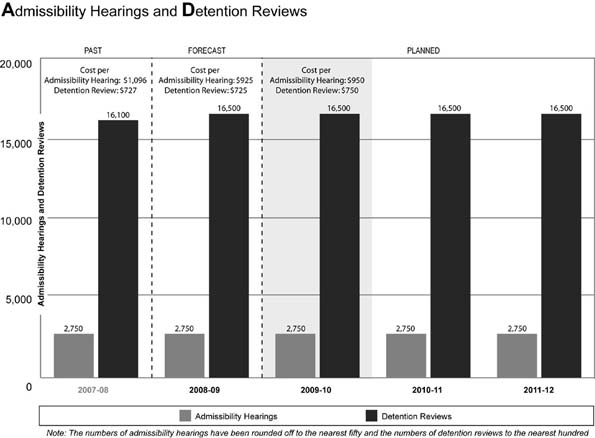
(Click on image to enlarge)
2009-10 Planning Highlights
Further increase capacity to resolve cases and manage the case inventory. The number of cases concluded by the ID depends on the number of cases referred by the CBSA. Over the past four years, referrals of admissibility hearings have increased by 23% while referrals of detention reviews have increased by 21%. Through enhanced efficiencies, the ID has managed the increased workload within existing resources and has been able to conclude cases within the legislated timeframe for detention reviews.
It is anticipated that the ID will continue to experience a moderate increase in referrals for admissibility hearings, while the number of detention reviews will remain high but stable. The ID will continue to prioritize detention reviews to ensure that legislative requirements and fundamental rights are respected.
In order to manage its case inventory, the ID will develop and implement case management standards. It is expected that more efficient case management will result in reduced adjournment and postponement rates, shorter processing times and increased capacity to resolve cases.
Strengthen relationships with partners and stakeholders. The ID will engage stakeholders and partners to seek their input on operational efficiencies. The ID will work with the CBSA to coordinate resources and ensure that cases are concluded rapidly and in a fair and cost effective manner.
Continue to build an integrated, flexible and effective organization. Quality standards will be developed in concert with the other program activities to ensure the delivery of well-reasoned decisions. Efficiency standards will be developed in conjunction with the Operations Branch. The focus will be on reducing the number of admissibility hearings that are pending for more than six months and finalizing the majority of new cases within this six-month timeframe.
Benefits for Canadians
The ID renders decisions that maintain the security of Canadian society and uphold Canada's reputation for justice and fairness to individuals. It is with this sense of responsibility that the IRB maintains the balance between individual rights and the security of the Canadian population throughout Canada's communities.
Program Activity 3
Immigration Appeal
| Description The IAD delivers the Immigration Appeal program activity. It hears immigration appeals from Canadian citizens and permanent residents whose applications to sponsor close family members to Canada have been refused. Other key functions include hearing appeals from permanent residents, foreign nationals with a permanent resident visa and protected persons who have been ordered removed from Canada, and permanent residents outside Canada who have not fulfilled their residency obligation. |
| Fiscal Year | 2009-10 | 2010-11 | 2011-12 |
|---|---|---|---|
| Financial Resources ($ Millions) | 13.2 | 13.2 | 13.1 |
| Human Resources (FTEs) | 115 | 115 | 115 |
| EXPECTED RESULT: Quality decisions rendered and cases resolved in a timely manner regarding immigration appeals | |
|---|---|
| Performance Indicator | Targets |
| Clarity, completeness and conciseness of IRB reasons for decisions | Develop criteria for samples of reasons for decisions. |
| Percentage of appeals finalized without a hearing | It is expected that 45% or more of appeals will be finalized without a hearing. |
| Ratio of finalized appeals to filed appeals | Approximately 7,000 appeals are expected to be filed in 2009-10. Based on the number of decision-makers available, we expect to finalize between 5,800 and 6,500 appeals. This will result in a ratio of finalized to filed appeals of 83% to 93%. |
| Average cost per appeal finalized | The average cost per appeal finalized will be between $2,700 and $3,000 depending on the number of appeals finalized. |
| Average appeal processing time | Based on the inventory and the available decision-maker complement, it is expected that the average processing time could increase to 11.5 months in 2009-10. |
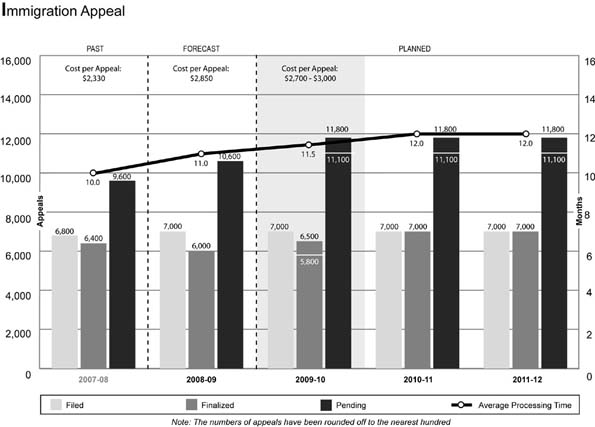
(Click on image to enlarge)
2009-10 Planning Highlights
Last year, the IAD experienced an average shortfall of 24% in decision-makers. Nevertheless, the IAD continues to build successful procedural, adjudicative and administrative practices that increase its efficiency, productivity and fairness.
Further increase capacity to resolve cases and manage the case inventory. The IAD will manage its caseload through innovative and effective case management and adjudication strategies that promote best practices and cross-regional consistency. These strategies will focus on early resolution without a hearing (including alternative dispute resolution), hearing readiness, proactive hearings and quality decisions that are made in a timely manner.
Strengthen relationships with partners and stakeholders. The IAD will continue to work closely with appellants' counsel groups as part of both national and regional IAD consultative committees as well as other avenues to share information and solicit cooperation in meeting common goals. The IAD will continue to work with the CBSA to quickly finalize appeals that the CBSA has screened for early resolution and facilitate the hearing of appeals where the Minister's counsel's has chosen to participate through written submissions only.
Continue to build an integrated, flexible and effective organization. The IAD will continue to respond flexibly to match resources with regional caseloads by sharing decision-makers among regions and by conducting hearings via videoconference. Tribunal officers and registry office staff will continue to work closely with members and member managers to provide effective adjudicative support and to resolve appeals without a hearing where possible.
Benefits for Canadians
Through the sponsorship appeals work, the IAD recognizes the contributions of immigrants to the strength and vitality of Canadian society and culture, as well as the Government's commitment to family reunification. Through the removal order appeals work, the IAD recognizes the consequences of the decisions it makes with respect to enhancing public safety while balancing this with individual rights.
Program Activity 4
Internal Services
| Description Internal Services are groups of related activities and resources required to support the needs of all three tribunal programs and other corporate obligations of the IRB. These services are: Management and Oversight; Communications; Legal; Human Resources Management; Financial Management; Information Management; Information Technology; Materiel; Acquisition; and Other Administrative Services. Internal Services include only those activities and resources that apply across an organization and not to those provided to a specific program. |
| Fiscal Year | 2009-10 | 2010-11 | 2011-12 |
|---|---|---|---|
| Financial Resources ($ Millions) | 28.5 | 28.4 | 28.3 |
| Human Resources (FTEs) | 257 | 257 | 257 |
2009-10 Planning Highlights
Management and oversight. At the end of the previous reporting period, the IRB restructured its advisory committees and created an independent audit committee. In 2009-10, the IRB will implement the Chief Financial Officer model in accordance with the new Policy on Financial Management Governance. These changes will improve senior management decision-making support and enhance oversight for the Board's activities.
Communications. The IRB will continue to improve understanding of its mandate and role, share best practices and find opportunities to collaborate with national and international partners as well as non-governmental organizations, other tribunals, parliamentarians, the media, the public and counsel through its communications and outreach efforts.
Legal. Legal Services will focus its activities on providing training and support to new decision-makers and offering advice, including risk analysis, regarding innovative adjudicative strategies and their implementation in support of the Board's inventory management. Legal Services will work to ensure that the various aspects of operations, service delivery, policy development, corporate direction and management decisions are in compliance with all relevant legal requirements.
Human Resources management. The IRB will continue to foster an environment where people management is valued and recognized as a priority in achieving its strategic outcome. The IRB recognizes that training for its decision makers and adjudicative support staff is crucial to maintaining and enhancing the quality of its core business of resolving, hearing and deciding cases. The IRB will focus on the implementation of a talent management initiative and on strengthening continuous learning and professional development initiatives for decision-makers and public service employees in order to optimize the potential of the Board's human capital and achieve the broader goals of the Government's Public Service Renewal Action Plan.
Financial management. The IRB will focus its efforts on implementing the new suite of Treasury Board Secretariat (TBS) financial policies and directives. This will include impact analysis, amendments to existing internal processes and practices, communications and training.
Information management. The information management focus will be on implementing a new IRB function-based classification structure and on providing support and guidance to senior management on this and other related information management matters.
Information technology. The IRB, in accordance with its three-year strategic information technology plan, will focus on the planning and tactical deployment of process improvement strategies to ensure stronger internal and external business partnerships. In addition, we will continue ongoing maintenance and support of existing information systems and develop new solutions to meet business needs.
Procurement and assets management. The IRB will continue to strengthen its procurement functions through regular training sessions. We will improve internal processes in order to further eliminate duplication of effort. In addition, we will implement new asset management policies and procedures in order to enable effective, efficient, accountable and environmentally responsible activities related to the life-cycle management of IRB assets.
Internal audit and evaluation. The IRB will implement the new Government-wide Audit Policy and support the recently created IRB Audit Committee. The IRB will match its capacity to conduct audits and internal evaluations with the needs for continuous monitoring of IRB operations to provide senior management with improved information for decision-making, provide assurances regarding governance, risk management, stewardship and accountability, and improve overall management oversight.
Section III: Supplementary Information
List of Electronic Tables
The following electronic tables can be found on the TBS Web site at
http://www.tbs-sct.gc.ca/rpp/st-ts-eng.asp.
Table 3.3: Evaluations
Table 3.4: Internal Audits
Other Items of Interest
Legislation Administered
Immigration and Refugee Protection Act
(S.C. 2001, c. 27, as amended)
Immigration and Refugee Protection Regulations
(SOR/2002-227, as amended)
Refugee Protection Division Rules
(SOR/2002-228)
Immigration Division Rules
(SOR/2002-229)
Immigration Appeal Division Rules
(SOR/2002-230)
Oath or Solemn Affirmation of Office Rules
(Immigration and Refugee Board of Canada)
(SOR/2002-231)
IRB Processes
Visit these links to find out how the IRB processes its cases:
- Refugee Protection Claim Process
http://www.irb-cisr.gc.ca/en/references/procedures/processes/rpd/rpdp_e.htm - Admissibility Hearing Process
http://www.irb-cisr.gc.ca/en/references/procedures/processes/id/ahp_e.htm - Detention Review Process
http://www.irb-cisr.gc.ca/en/references/procedures/processes/id/drp_e.htm - Sponsorship Appeal Process
http://www.irb-cisr.gc.ca/en/references/procedures/processes/iad/sap_e.htm - Removal Order Appeal Process
http://www.irb-cisr.gc.ca/en/references/procedures/processes/iad/roap_e.htm - Residency Obligation Appeal Process
http://www.irb-cisr.gc.ca/en/references/procedures/processes/iad/resoap_e.htm
Related Information
UNHCR Web site: http://www.unhcr.org/home.html
Contact us
For more information, visit the IRB Web site at
http://www.irb-cisr.gc.ca
or contact the IRB Communications Directorate at 613-947-0803 or one of the IRB offices listed below.
National Headquarters
Immigration and Refugee Board of Canada
Minto Place—Canada Building
344 Slater Street, 12th Floor
Ottawa, Ontario K1A 0K1
Tel: 613-995-6486 Fax: 613-943-1550
Regional Offices
Eastern Region
200 René Lévesque Boulevard West
Guy-Favreau Complex
East Tower, Room 102
Montreal, Quebec H2Z 1X4
Tel: 514-283-7733 Fax: 514-283-0164
Central Region
74 Victoria Street, Suite 400
Toronto, Ontario M5C 3C7
Tel: 416-954-1000 Fax: 416-954-1165
Western Region
Library Square, Suite 1600
300 West Georgia Street
Vancouver, British Columbia V6B 6C9
Tel: 604-66-5946 Fax: 604-666-3043